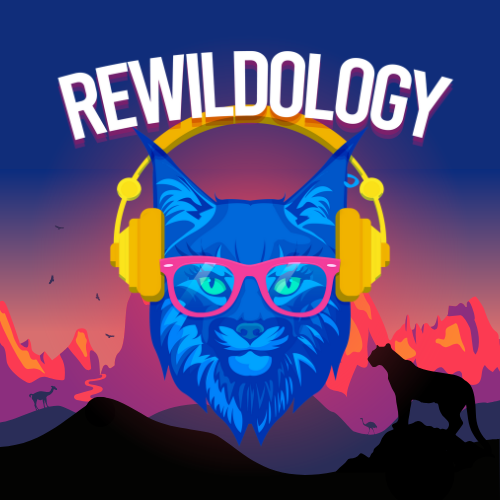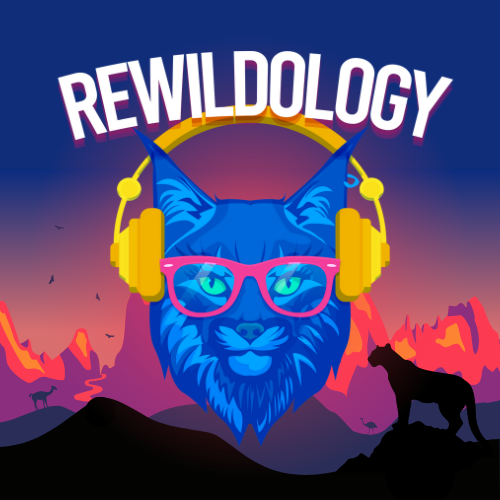Episode Transcript
[00:00:04] Speaker A: Now we're going to lower a little bit of voices and do subtle moves.
[00:00:08] Speaker B: I instinctively follow their lead, moving quietly through this remote facility in Patagonia National Park.
Inside the first enclosure, I catch my first glimpse of 18 Darwin's rhea chicks. The charitos, as Alejandra calls them.
Their tawny feathers a perfect camouflage against the dry grasses around.
[00:00:30] Speaker C: How old are these ones?
[00:00:34] Speaker A: In approximately five months, they already finished their two month succulentation. They have been longer here because we're waiting for the next group to come so that we release them all in the same group.
[00:00:48] Speaker B: As wildlife coordinator for Rewading Chile's breeding program, Alejandra has dedicated more than eight years to bringing these remarkable birds back from the brink.
The numbers tell a stark story.
[00:01:02] Speaker A: We did a study and we realized that we had 22 individuals in the whole park.
22 nothing. It's really endangered.
[00:01:10] Speaker B: Wow. What's unfolding here represents conservation at its most hopeful.
The methodical, patient work of bringing a species back from near extinction.
These charritos represent more than just individual birds. They're living proof that we can repair some of the damage humans have caused to wild ecosystems.
Welcome back to Rewadology.
I'm Brooke Mitchell and today we're exploring the remote Iceland region, home to some of Patagonia's most breathtaking landscapes and ecological treasures, including Patagonia national park, where an ambitious effort to restore an entire ecosystem is unfolding before our eyes.
Our journey begins as our small plane touches down at Bao Meceda's tiny airport.
Together, Hazelina, Nicole and I meet Carlo, our guide for the next few days, and this remarkable but special sparsely populated region, an area about the size of Switzerland, but with only 100,000 people scattered across its rugged landscape.
The dramatic shift in climate and scenery from a previous location in Pumaling Douglas Tompkins national park is immediately apparent.
The Isen region represents Chilean Patagonia at its most untamed. A place where the Andes Mountains fracture into a complex mosaic of peaks and glaciers, forests and steppe.
Our journey continues along the legendary Carreterra Austral, the Southern Highway, a road that wasn't completed until the 1980s and still maintains a frontier feel.
This ribbon of gravel opened up a previously isolated wilderness, connecting remote communities and making conservation projects like Patagonia national park, except accessible to the world.
Our first overnight stop brings us to the base of another spectacular protected area, Cerro Castillo National Park.
This relatively new addition to Chile's park system is dominated by the jagged Cerro Castillo Massif, a mountain whose castle like spires give the park its name.
The dramatic ice carved granite towers rise directly from the surrounding landscape like something from a fairy tale.
If Elsa from Frozen was real, this is definitely where she lived. It's that magical and otherworldly.
As the setting sun illuminates the rock face in shades of golden amber, we settle into our homestay at La Cozona in the small community outside the park.
The park protects diverse ecosystems from Patagonian steppe to Notafagos forests, serving as a crucial ecological connector between the temperate rainforests to the north and the arid grasslands to the south.
The next morning, we continue our journey southward.
Rounding a bend in the road, we catch our first glimpse of General Carrera Lake, South America's second largest lake whose startling turquoise waters reflect the massive glaciers that feed it.
We pause our drive for a boat tour of the ferry famous marble caves.
As our small boat heads towards these remarkable formations, I'm struck by the lake's otherworldly blue color. The distinctive turquoise hue comes from rock flower glaciers grinding the mountains into a fine powder that remains suspended in the water.
The caves themselves defy adequate Description.
Carved by 6000 years of wave action, these smooth marble chambers create cathedral like spaces where swirling patterns of white and gray marble are reflected in the luminous blue water below.
Our boat glides through formations with names like the Elephant, the Cathedral, the Chapel and the Marble Cave.
What makes these formations even more remarkable is that we're only seeing seeing their tips. These caves are actually the exposed marble tops of monoliths that extend hundreds of feet below the water surface.
As we continue south after our boat tour, the landscape opens up dramatically.
The dense forests give way to Patagonian steppe, a vast expanse of golden grasses where the eye can travel uninterrupted for miles.
After an overnight in the frontier town of Cochran at Ultimo Paraiso, with its rustic charm and spectacular stargazing, we finally arrive at our destination, Patagonia National Park.
Stepping out at the park headquarters, I stopped to take in the beauty of this landscape.
Unlike the dramatic peaks of Torres Alpine or the lush forest further north, Patagonia national park offers a different kind of grandeur.
Vast open spaces where your eyes travel across golden grasslands punctuated by meandering rivers and framed by distant mountains.
This park represents something truly revolutionary in conservation history.
Just 15 years ago, this was Estancia Valle Chacabuco, a massive sheep ranch where overgrazing had degraded once once rich grasslands.
The transformation began when Christine and Douglas Tompkins purchased the 20,000 acre property in 2004. Through their foundation, with A vision to restore the natural ecosystem and donate it as a national park.
As we toured the beautifully designed visitor center with its museum and restaurant, built from local stone and recycled wood, we learned how the park came to be.
The park sits in a unique position as an east west valley that creates a pass over the Andes Mountains, making it a natural corridor for wildlife movement between Argentina and Chile.
The park's formation was finalized in 2018 when Chilean President Michel Bachelet and Chris Tompkins signed a decree officially creating five new national parks.
Patagonia national park combined with the former Estancia Valle, Chacabuco, with the neighboring Haine and Cochran National Reserves, to create a protected area of approximately 640,000 acres.
What makes this land particularly special is its location in a transition zone between the arid Patagonian steppe to the east and the southern beech forest to the west.
This creates a remarkably diverse landscape within a relatively small area.
The restoration work began immediately after the Tompkins purchase, with the removal of hundreds of kilometers of fencing that had fragmented the landscape.
Native grasses were reseeded in areas damaged by overgrazing, and a comprehensive plan was created to re establish the natural balance of the ecosystem.
As we walk a trail through golden grasslands, we spot a herd of guanacos grazing peacefully on a distant hill.
These camelids are keystone species in the Patagonian ecosystem, and their return in large numbers is one of the park's greatest success stories.
Throughout the park, evidence of ecological recovery is everywhere, from the increasing number of wanakos to the return of poor humas and the restoration of native plants.
The turquoise waters of Baker and Chacabuco rivers cut through the landscape, providing habitat for native fish, though introduced trout and salmon also inhabit these waters.
But while the wanako population has rebounded quickly, other species face greater challenges.
The endangered wamul deer, an iconic species that appears on Chile's National Coat of Arms, numbers only about 1500 individuals in the wild.
Patagonia national park contains one of the largest remaining populations, with 100 to 200 individuals roaming its protected valleys.
And then there's the Darwin's rhea, a species that was nearly lost from this landscape entirely.
To understand this remarkable conservation story, we've arranged to meet Alejandro Saverdra, wildlife ranger and coordinator of Rewading, Chile's breeding center, who has dedicated her career to bringing these remarkable birds back from the brink of extinction.
Emiliana Redemal, a veterinarian student taking care of the rias alongside Alejandra, is our translator.
[00:10:28] Speaker C: And this is the Darwin Ria, right.
[00:10:40] Speaker A: Is the indigenous Name for this species, beautiful charitos. Los B and chitos, the babies now in the cages, we only have chitos that are the babies around 18, 18 charitos, 18 babies.
[00:11:00] Speaker B: Darwin's rhea, called nandu locally or choiki in indigenous languages, play a critical ecological role in the Patagonian steppe.
Standing about 3ft tall, with long necks and powerful legs, these flightless birds are nature's gardeners, dispersing seeds, maintaining grassland health through their foraging and serving as prey for apex predators like pumas.
As we approach the enclosures, I catch my first glimpse of the future of this species. Eighteen charritos, about five months old, their tawny feathers blowing in the wind.
The path to recovery for the Darwin's rhea began with an unexpected discovery.
In 2014, border police stationed near the Argentina boundary found two orphaned rhea chicks. They contacted Tompkins Conservation who were already monitoring the declining rhea population.
This chance event sparked the beginning of the breeding program.
[00:11:59] Speaker A: So we tried to involve the policemen a lot in our work because thanks to them, we started working with the rias. They were the ones that found the first two eggs, two boyfriend eggs. And they gave them to Cristian Salcedo and to Rualdig that nested in conservation.
[00:12:19] Speaker B: Yes, yes. Pre rewatting Chile.
[00:12:21] Speaker A: Yeah, they gave the eggs to them. And that's when Cristian Salcedo said, okay, we need a reproduction center. We need to start doing this work with the rheas and everything.
[00:12:30] Speaker B: As we walk along the enclosure's fence line, Alejandra explains how their approach differs from traditional captive breeding programs.
Every rhea raised here is destined for release.
The process begins with eggs and chicks baked, donated from a reserve called Kiman in southern Chile, about 1,000 kilometers away.
This genetic diversity is crucial for establishing a healthy population.
[00:12:56] Speaker A: In the beginning, we only used the reproduction males and females that we had in the other point, Yandu. And now we're bringing genetics from another place, so we're mixing it up a little bit to start liberating them.
[00:13:10] Speaker B: Oh, nice.
[00:13:12] Speaker A: So now we're receiving donations of charitos and adults, sometimes from the rivers region.
And it's 1,000 kilometers from here.
[00:13:24] Speaker B: These birds spend approximately two months in these acclimation enclosures, just long enough to gain strength, but not so long that they become habituated to humans.
Finding this balance is an art that Alejandro has perfected over years of working with the species.
[00:13:40] Speaker A: So we chose the two months acclimatization time because of two factors. One, in two months they look bigger, they have more mass and they are stronger, taller, and they Start running more. So that is the time when they can survive or run from pumas or foxes or anything. And because in wildlife, we have seen that choike and choritos, at the four months or three months, they start separating from their fathers. So that's why we chose two months of mutation here.
And it's not convenient to have them for more than two months because they start getting, like, habituated. Habituated.
[00:14:29] Speaker B: Recent census efforts show the wild population has grown significantly from the original 22 individuals they found in this valley.
[00:14:36] Speaker A: The census that we have been doing lately, the Last one was 76, the last census. So we're not completely satisfied with this number. We're going to keep working with them until we see that they can live freely without help from us. But we know that we've been doing a great job because we can see it in the numbers.
[00:15:00] Speaker B: The program has created a network of observers throughout the region to help monitor the population.
[00:15:06] Speaker C: Do you do citizen science? So if people are visiting the park and they see the rias, can they tell you the data of where they're at?
[00:15:14] Speaker A: So not the tourists that come can give us this data, but the people that work in the park do. So a lot of people that work in tourism with Explora, or people that work in Conaf, or the people, especially the policemen that are further east from us, they are the ones that usually are the first ones to see the nitifications and the eggs, because they're way up in the places that this beautiful thing happens. So they are the first ones to tell us where it's happening, where there are the eggs and everything.
[00:15:47] Speaker B: As our conversation with Alejandra continues, we delve into the broader context of ria conservation in this specific region.
The Darwin's rhea isn't globally endangered, but their situation in Patagonia national park tells a different story about localized extinction and recovery.
[00:16:06] Speaker A: But the thing is that in this place, the rhea is endangered. Not like, not globally, but, like, nationally, it's not. But the species from this zone, it is. It was really endangered. So that's when we started working with the reproduction center.
[00:16:21] Speaker B: The historical context explains everything.
This entire area was once an estancia, a massive cattle and sheep ranch that profoundly altered the ecosystem.
[00:16:32] Speaker A: So the most important differences between this part of the region and the north of Koyaque is that this place was really used for cattle. So this whole terrain was used for that. And there was a lot, a lot, a lot of fences that prevented the animals from going to a place to another. So they were chased, they were captured, they ate the eggs and so that's why they were so close to human population, that that meant that the animals started going, the numbers started going down.
[00:17:03] Speaker B: Over her eight years with the program, Alejandra has been part of remarkable progress.
The breeding program has released 130 animals in total at the time of this record recording. And she's witnessed encouraging behavioral changes in the wild population.
[00:17:18] Speaker A: We have liberated 130 animals now and we have been seen only monitoring that we've been able to make a change. We've been seeing a lot of reproduction, more males trying to follow the babies and more dispersion through along the territory.
So we can see that something is happening, that we're doing something right, but we need to confirm it.
[00:17:45] Speaker B: What strikes me most about Alejandra's work is her personal goal for the project.
She wants to track adult male rheas with GPS to confirm they're successfully reproducing in the wild.
[00:17:56] Speaker A: So it's difficult for us to track them because we liberated them when they're babies.
So they do tend to grow a lot with these type of animals. We can't put the trackers in their feet. That is the most common thing to do with birds. Yeah, we can't do that because we won't see them. If you see the pampa and this field, we don't see the feet of the animals so it would be useless.
So the neck is the only place that we can see and track it.
But the neck grows a lot in some months and years. So so we the next stops growing at the a year and a half mark and we liberated them when they are like four months. So we can't put something that would be like strangling them.
[00:18:43] Speaker B: Right, right, right.
[00:18:44] Speaker A: So we put on them, we do mark them with like necklaces that when they go or they get stuck on anything, they get off.
[00:18:53] Speaker B: Oh, okay.
[00:18:54] Speaker A: So they tend to last long like some weeks. And that allows us to see them in their first periods of liberation. But that's it. Her personal goal here is to be able to mark an adult, a male adult with GPS and telemetry so that we can follow them and see the reproduction, confirm that they are reproducing well in the nature of and the numbers that they're gaining in the eggs and everything.
[00:19:27] Speaker B: This desire to verify success through scientific monitoring demonstrates the rigorous approach that underpins this work.
It's not enough to release birds. The goal is to establish a self sustaining wild population that can thrive without human intervention.
But Alejandra faces three major challenges in her work.
The first is genetics, a common problem with small, isolated populations.
[00:19:54] Speaker A: The biggest problem for us is the genetics.
[00:19:58] Speaker B: It's a small number, small number that.
[00:20:00] Speaker A: It'S really difficult for us to start mixing it up and start bringing in more genetics. We're really restricted from the places that we can actually achieve and more animals and more genetics. From Chile, there's not a lot of reproduction centers. So we have been working three years now with reservaquiman, and we know that in, I don't know, one year or two years, we have to start working with them and start working with another reproduction center to start bringing in more genetics.
[00:20:28] Speaker B: The second challenge is community engagement. Despite the program's success, local communities in Cokran haven't fully embraced the project.
[00:20:38] Speaker A: And also the second problematic thing that we have with this project is that we have. We have seen that communities from Cochran don't really connect with the park, first of all, and with the project, secondly. So we've been trying to connect them and bring them in. We've been bringing students from the school and people to see the liberations and everything. But it's been hard because the community doesn't really connect with the park.
So they know that we work with this. They know Ale from Ria, they know that she works with this, with the species, but they don't really come and involve themselves with this. And it's something that belongs to them, this situation. Their parks is their park too. So we really want them to be involved in this and to see that this is their territory too, like they need to own it. We want them to own this project.
[00:21:40] Speaker B: The third challenge speaks to the complexity of ecosystem restoration, the need to work holistically rather than focusing on individual species.
[00:21:50] Speaker A: A third challenge. Well, she says that there are a lot of challenges in this project, but a third important one is that in this steep step, we can see that we don't own only have brias or guanacos. We have a lot of different fauna and animals here. And for them to all prosper and everything, we need to work as a whole, not only landscape.
So the challenge for us is to try to work with this with the Ria, with the condo, with the puma, with the Wemu, and start involving all other species and plants and everything for all of it to grow and start evolving with as a whole. So for us, it's difficult to gather all of these challenges and work in everything, all of it at once.
[00:22:37] Speaker B: Despite the challenges Alejandra described, the vision remains clear.
A wild Patagonia where ecological processes can unfold naturally, where wildlife can move freely across the landscape, and where local communities benefit from, from, and participate in conservation efforts.
On our last hike in Patagonia national park, we're greeted with gentle rain that turns into snow and covers the ground in a light white blanket.
As we trek eyes on the landscape for Puma, I reflect on everything we've experienced in the Isen region over the past few days.
From the ethereal beauty of the marble caves to the castle like spires of Cerro Castillo, from the rich biodiversity of Patagonia national park to the dedicated conservation work happening at the Ria Breeding Center.
This region, once dominated by vast sheep and cattle ranches, is undergoing a remarkable transition.
My time with Alejandra and the Darwin's Rhea has offered a window into what conservation can look like like when it goes beyond preservation to active restoration.
It's not just about protecting what remains, but about bringing back what has been lost.
This is what rewilding looks like in practice.
I'm Brooke Mitchell and this has been another journey across the rooted parks of Patagonia.
Until next time, remember that in the wild heart of Patagonia, a remarkable story of ecological restoration is unfolding.
One bird, one guanako, one removed fence at a time.
Next time on rewildology, we venture deeper into Chilean Patagonia to explore one of Earth's most dramatic and rapidly changing landscapes, the massive ice fields that crown the southern Andes.
I sit down with glaciologist Dr. Ines Doucellent to understand what's happening to Chile's glaciers and and what their changes mean for ecosystems, communities and our planet's future.
From ancient ice, telling stories of climate history to the urgent realities of glacial retreat, we'll discover how these frozen giants are both witnesses to and victims of our changing world.
[00:25:04] Speaker C: I want to invite you to become part of something bigger than just this podcast.
This series is actually one pillar of a larger initiative called rewildology's Project Project Patagonia where conservation truly meets adventure.
Project Patagonia is built on three Listen, experience and protect.
You're already participating in the first pillar by listening to this podcast series, but if you're inspired to go deeper, you can join us in the field for the second pillar experience.
In April 2026, I'll be leading a small group of just 10 people on an unforgettable expedition to trek Pumas and explore the majestic mountains of Torres the Paine National Park.
This intimate adventure includes expert led Puma tracking, meetings with conservation researchers, hiking through breathtaking landscapes and even kayaking to the magnificent great Glacier.
You'll literally follow in the footsteps of of the stories you're hearing in this podcast.
The third pillar, Protect, is where your passion can translate into direct conservation impact.
Through our partnership with Panthera, the global wild cat conservation organization, your support helps fund crucial work to protect pumas and their habitats throughout Patagonia.
Your donations help bridge divides between fragmented habitat, develop solutions for human wildlife conflict, implement wildlife corridors, and support cutting edge research.
Whether you choose to listen to this series, join our expedition, make a donation, or all three, you become part of a community dedicated to preserving one of Earth's most spectacular regions.
To learn more about Project Patagonia and how you can get involved, visit rebotology.com Project Patagonia Together, we can ensure that the root of parks of Patagonia continues to thrive for generations to come.



